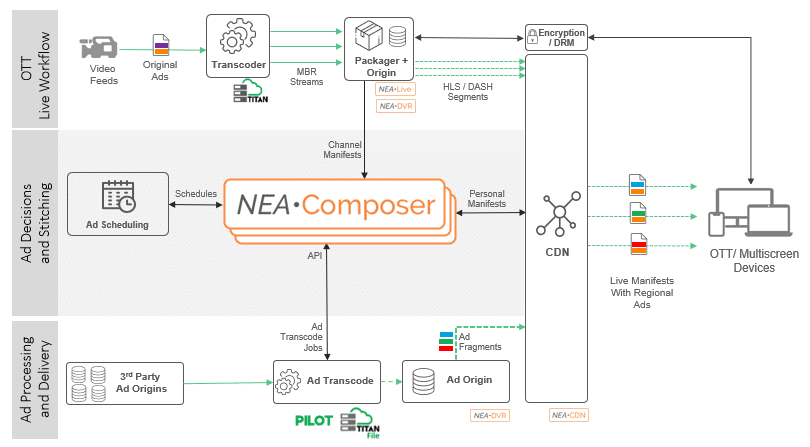OTT is a powerful thing. It first disrupted the TV viewing model by offering personalized viewing experiences in terms of when and on which screen viewers watch their favorite content. Now, it is set to go one step further by offering the possibility of personalized content – enabling greater loyalty and new revenue streams. Personalization is the holy grail of OTT. But a first step toward that holy grail is to reproduce in OTT what has been happening for many years in IPTV and cable networks: regionalizing live streams, also known as “Linear Parity”.
The Need for Linear Parity
This is actually mandatory for cable, IPTV and OTT video operators in North and South America. Government bodies require them to regionalize live channels before distributing them into their different territories. While each country has different rules, typically operators must replace national sporting events with local events or content. And while live streams usually keep national ads for the different regions, regional ad slots (usually 2 to 4 minutes per hour) are replaced with regional ads targeting the various territories that the operator reaches.
The OTT Challenge: Linear Parity
Transport stream (TS) splicers are a very common legacy tool to achieve this regionalization workflow for TS streams. But operators are now facing a new challenge: How can they regionalize HLS and DASH streams reliably for OTT delivery? Here are some questions you might have if you want to achieve for live OTT the same regionalization that is already possible on broadcast:
- Is there a system that enables ad regionalization for Live HLS and DASH streams?
- Does the same system enable content alternation, so that I can replace content without having to create architecture silos?
- How easy is it to add or modify zones for regionalized ads or content? Do I need to re-encode signals for each zone?
- How will the system handle ad schedules that come from different ad agencies for different territories?
- Is the system a future-proof investment? What if I decide to expand my ad-insertion requirements to fully addressable TV targeting, reaching specific households?
Meeting the Challenge
Manifest Manipulation is the perfect answer to all the above questions. Regionalizing ads with manifest manipulation is a natural fit for HLS and DASH delivery, as segments of regional ad slots are replaced in outgoing manifests to different users. The manifest manipulator receives the regional ad schedules (typically in CCMS format) from ad scheduling systems and uses them to decide which regional ad to insert in outgoing manifests to viewers in different territories.
Sometimes ad schedules come in different formats. In that case, a translator must be used to unify the scheduling structure before pushing them to the manifest manipulator.
Manifest Manipulation versus TS Splicers
The manifest manipulation architecture is much more efficient than legacy hardware TS splicers. It does not require re-encoding of services in order to add regional zones. Hardware splicers are also famous for inaccurate timing insertions due to internal clock drifts. And Manifest manipulation consumes less rack space and power, which makes it a more environmentally friendly choice as it reduces the impact of video streaming on our planet.
The same manifest manipulation workflow can be used for content alternation. A Placement Opportunity Information System (POIS – Placement Opportunity Information System) could be added next to the manifest manipulator to carry the regional restrictions – i.e. which content to be replaced with what, and for which regions. These restrictions are then communicated to the manifest manipulator via VAST protocol in order to make the right content alternation decisions for each viewer session.
While thinking about linear parity, operators must also consider future requirements to adopt fully addressable advertising (household targeting). This is an essential requirement because it can increase the operator’s ad revenue streams. In fact, manifest manipulation was invented for individual / household / addressable ads. The main difference between linear parity with manifest manipulator and fully addressable ads is that the ad decisions are individual instead of regional.
Implementing linear parity with manifest manipulation is a wise strategy, a green choice, and a future-proof investment.
The diagram below illustrates Ateme’s reference linear parity architecture:

You can find out more about the components used and the workflow here.

